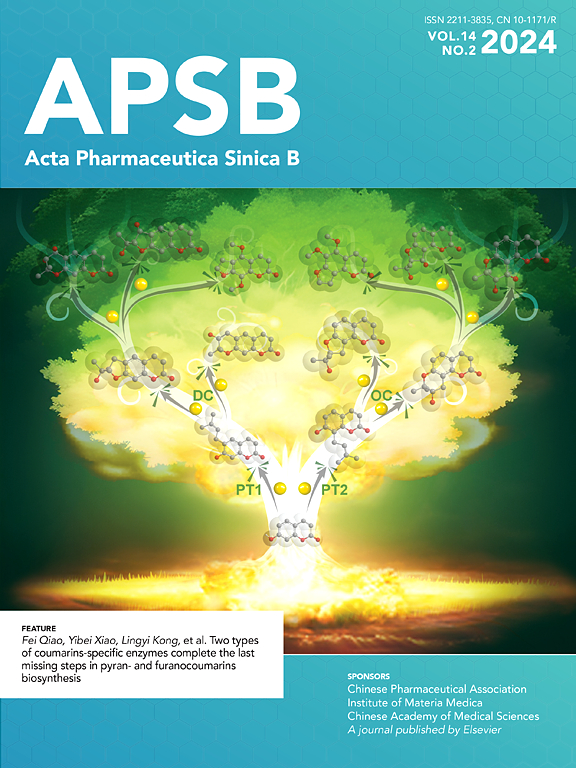在开发治疗阿尔茨海默病的新药过程中对多个靶点进行综合研究
IF 14.7
1区 医学
Q1 PHARMACOLOGY & PHARMACY
引用次数: 0
摘要
阿尔茨海默病是痴呆症的一个重要诱因,在21世纪迅速成为一个严重的医疗保健问题。阿尔茨海默氏症患者的惊人数量正在稳步增加,这是由于缺乏治疗方案造成的。目前阿尔茨海默病的治疗严重依赖对症治疗,尽管在药物开发方面投入了大量资金,但这种治疗仍未能治愈该病。临床有限药物治疗阿尔茨海默病一般以抑制n -甲基-d-天冬氨酸受体和乙酰胆碱酯酶为目标,仅在有限的时间内提高认知水平。除了前面提到的分子靶点,β-淀粉样蛋白的探索很少成功,因此人们越来越重视发现新的假定和新颖的AD靶点。这激发了药物化学家探索新的靶点,包括小胶质细胞、髓样细胞2 (Trem-2)上表达的触发受体和notum羧酸酯酶,以发现新的先导化合物。本文综述了ad相关靶点在阿尔茨海默病治疗和保护中的功能、病理生理作用和重要性。本文章由计算机程序翻译,如有差异,请以英文原文为准。

Comprehensive investigation of multiple targets in the development of newer drugs for the Alzheimer's disease
Alzheimer's disease, a significant contributor to dementia, is rapidly becoming a serious healthcare concern in the 21st century. The alarming number of patients with Alzheimer's disease is steadily increasing, which is contributed by the dearth of treatment options. The current treatment for Alzheimer's disease is heavily dependent on symptomatic treatment that has failed to cure the disease despite huge investments in the development of drugs. The clinical treatment of Alzheimer's disease with limited drugs is generally targeted towards the inhibition of N-methyl-d-aspartate receptor and acetylcholine esterase, which only elevate cognition levels for a limited period. Beyond the aforementioned molecular targets, β-amyloid was much explored with little success and thus created a feel and palpable growing emphasis on discovering new putative and novel targets for AD. This has inspired medicinal chemists to explore new targets, including microglia, triggering receptors expressed on myeloid cells 2 (Trem-2), and notum carboxylesterase, to discover new lead compounds. This review explores the functions, pathophysiological roles, and importance of all AD-related targets that address therapeutic and preventive approaches for the treatment and protection of Alzheimer's disease.
求助全文
通过发布文献求助,成功后即可免费获取论文全文。
去求助
来源期刊

Acta Pharmaceutica Sinica. B
Pharmacology, Toxicology and Pharmaceutics-General Pharmacology, Toxicology and Pharmaceutics
CiteScore
22.40
自引率
5.50%
发文量
1051
审稿时长
19 weeks
期刊介绍:
The Journal of the Institute of Materia Medica, Chinese Academy of Medical Sciences, and the Chinese Pharmaceutical Association oversees the peer review process for Acta Pharmaceutica Sinica. B (APSB).
Published monthly in English, APSB is dedicated to disseminating significant original research articles, rapid communications, and high-quality reviews that highlight recent advances across various pharmaceutical sciences domains. These encompass pharmacology, pharmaceutics, medicinal chemistry, natural products, pharmacognosy, pharmaceutical analysis, and pharmacokinetics.
A part of the Acta Pharmaceutica Sinica series, established in 1953 and indexed in prominent databases like Chemical Abstracts, Index Medicus, SciFinder Scholar, Biological Abstracts, International Pharmaceutical Abstracts, Cambridge Scientific Abstracts, and Current Bibliography on Science and Technology, APSB is sponsored by the Institute of Materia Medica, Chinese Academy of Medical Sciences, and the Chinese Pharmaceutical Association. Its production and hosting are facilitated by Elsevier B.V. This collaborative effort ensures APSB's commitment to delivering valuable contributions to the pharmaceutical sciences community.
 求助内容:
求助内容: 应助结果提醒方式:
应助结果提醒方式:


